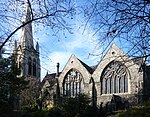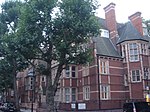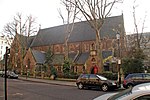Kensington and Chelsea (UK Parliament constituency)

Kensington and Chelsea was a constituency represented in the House of Commons of the Parliament of the United Kingdom 1997–2010. It was one of the safest Conservative seats in the United Kingdom, and since its creation in 1997 became a prestigious seat, with MP Alan Clark, the former Defence Secretary Michael Portillo and the former Foreign Secretary Malcolm Rifkind all holding the seat for the Conservatives. The seat was abolished for the 2010 election, when the 1974–1997 Kensington constituency was recreated and Chelsea formed a new constituency together with the southern part of the former Hammersmith and Fulham constituency, called the Chelsea and Fulham constituency.
Excerpt from the Wikipedia article Kensington and Chelsea (UK Parliament constituency) (License: CC BY-SA 3.0, Authors, Images).Kensington and Chelsea (UK Parliament constituency)
Ashburn Gardens, London South Kensington (Royal Borough of Kensington and Chelsea)
Geographical coordinates (GPS) Address Nearby Places Show on map
Geographical coordinates (GPS)
| Latitude | Longitude |
|---|---|
| N 51.494 ° | E -0.186 ° |
Address
Wickham Court
Ashburn Gardens 7-8
SW7 4DG London, South Kensington (Royal Borough of Kensington and Chelsea)
England, United Kingdom
Open on Google Maps











